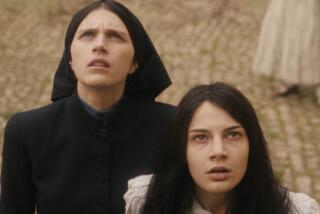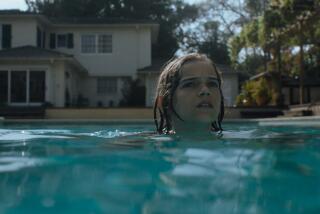Film Reviews : Russell’s Silly, Bearable ‘Lair of the White Worm’
- Share via
With “The Lair of the White Worm” (selected theaters), you’re certain for once that England’s perennial, prolific enfant terrible Ken Russell is being intentionally funny. While an abundant sense of humor cannot save the film from terminal silliness, it might make watching it bearable and even sometimes amusing.
Considering Russell’s well-deserved reputation for the bizarre and for sheer wretched excess, you’d be foolish to be taken in by the restraint with which the film begins in England’s beautiful Peak district in Derbyshire. Angus (Peter Capaldi), a Scottish archeologist, staying at the inn run by the Trent sisters, Mary (Sammi Davis) and Eve (Catherine Oxenberg), uncovers a curious, unrecognizable skull. You can be sure that all hell will soon be breaking loose in this story drawn from Bram Stoker’s final novel.
It seems that the sisters’ farm is on the site of an early Norman-era convent, built on Roman ruins from what was once the ancient kingdom of Mercia. On the mosaic floor Angus uncovers in the Trents’ garden there is a central design of a great white worm (or snake), coiled around a crucifix. Legend has it that the ancestor of Lord James D’Ampton (Hugh Grant, the aristocratic co-star of “Maurice”), whose vast estate is nearby, slew the white worm that inhabited Stone Rigg Cavern.
While these four young people act as if they were caught up in a Nancy Drew-Hardy Boys mystery, another neighbor, Lady Sylvia Marsh (Amanda Donohoe), comes on like Maria Montez, all kink and slink with her provocative gowns, insinuating manner and penchant for thigh-high stiletto-heeled black boots. It’s scarcely giving anything away to reveal that she is more than a menace to the virginity of local youths.
The film’s far-from-serious aura allows Russell to get away with some hilariously cut- rate visions of hell, various Christian-pagan conflicts and lurid Freudian symbolism. The film’s contemporary setting also allows for a witty sense of anachronism, but “The Lair of the White Worm” could have benefited considerably from the period quaintness of having been set in 1911, the year in which Stoker, creator of “Dracula,” wrote it. In any event, this would-be thriller of the supernatural is at all times funnier than it is scary. “The Lair of the White Worm” (rated R for sex and violence) is too thin and scattershot to recommend it, but it might be worth renting once it’s available on videocassette.
More to Read
Only good movies
Get the Indie Focus newsletter, Mark Olsen's weekly guide to the world of cinema.
You may occasionally receive promotional content from the Los Angeles Times.










